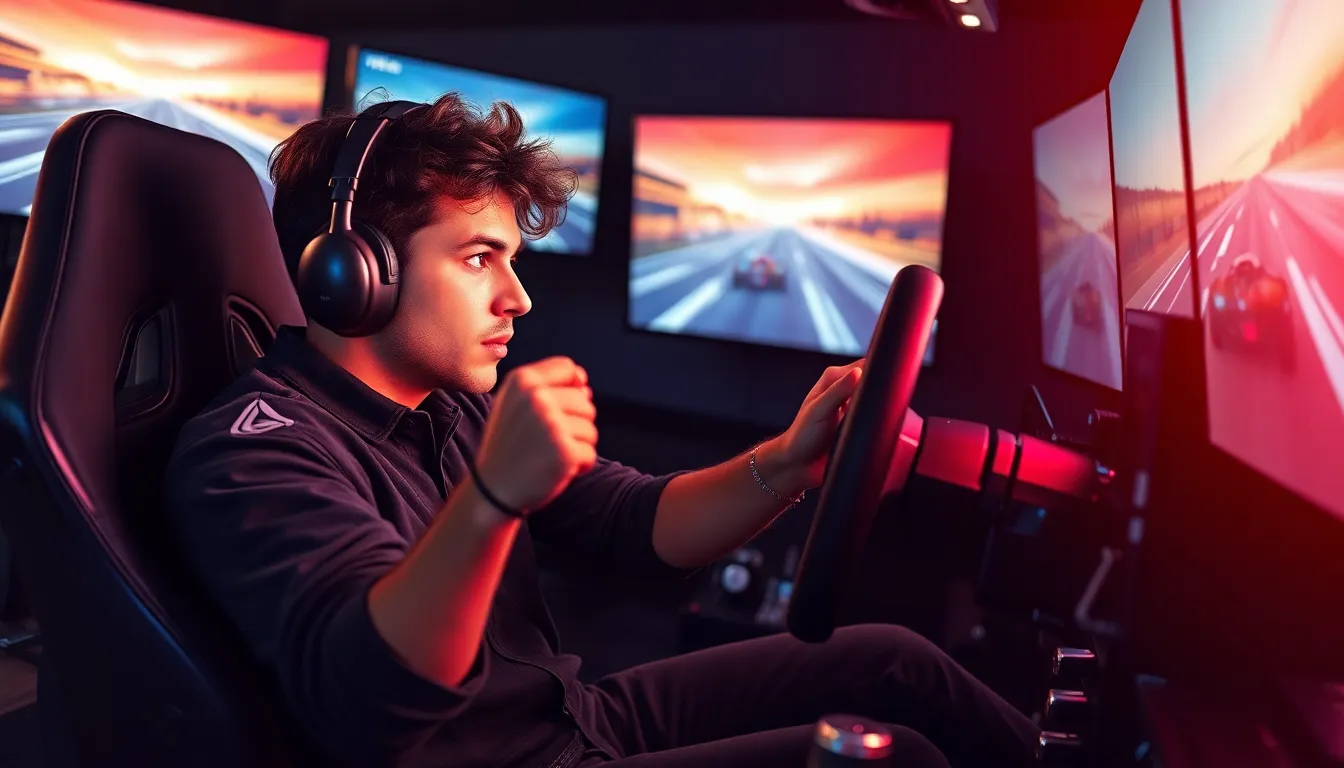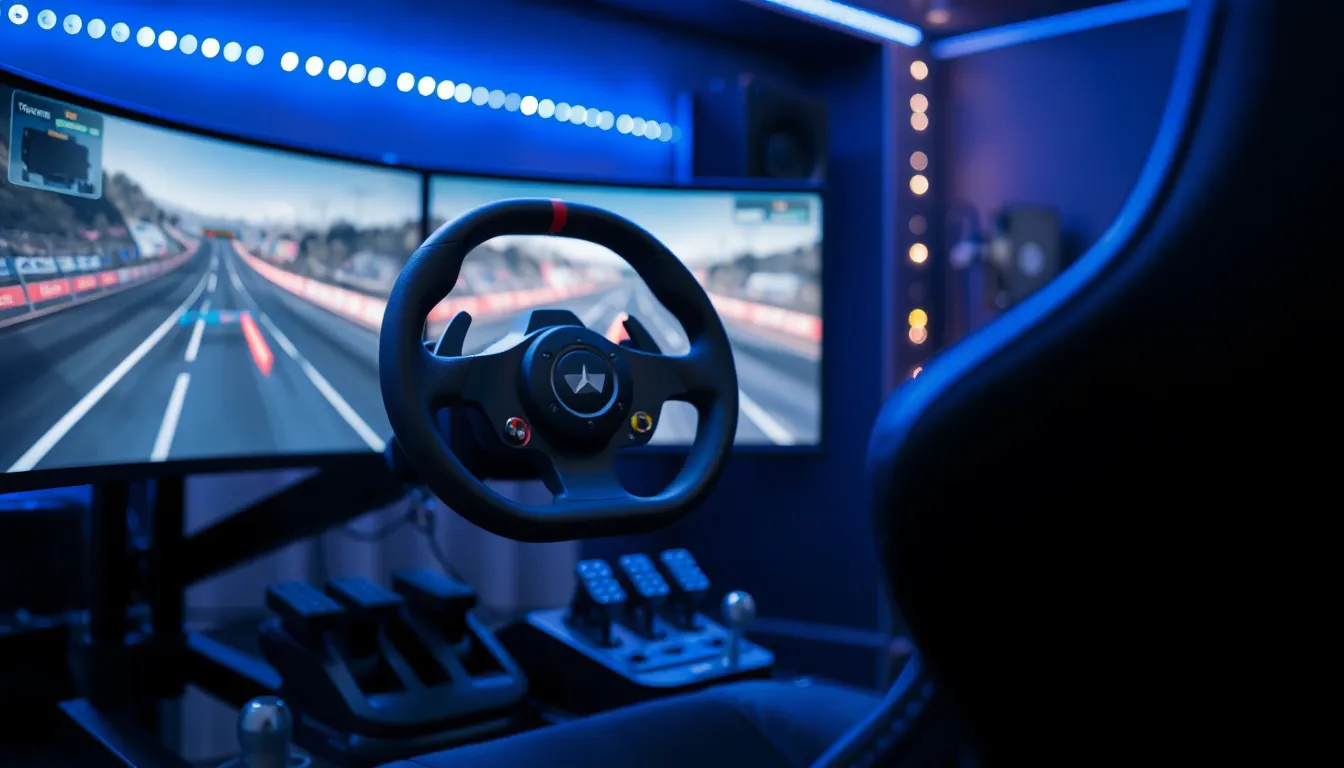
Extreme Sim Racing: Experience the Thrill of High-Speed Realism Like Never Before
Buckle up and prepare for a wild ride into the adrenaline-fueled world of extreme sim racing! It’s not just a game; it’s a full-throttle experience that combines the thrill of racing with the precision of simulation. Picture this: heart-pounding speed, jaw-dropping graphics, and the kind of realism that’ll have you questioning if you should’ve skipped breakfast or just strapped in for the ride of your life.
Extreme Sim Racing
Extreme sim racing represents a thrilling blend of high-speed racing mechanics and lifelike simulations. Participants engage in competitive racing environments that replicate real-world physics, vehicle dynamics, and track conditions. This form of racing utilizes advanced hardware and software to create an authentic experience that includes realistic steering responses and force feedback systems.
Gamers use high-quality racing wheels, pedals, and sometimes even full motion simulators to enhance immersion. Settings for extreme sim racing often include various racing disciplines, from Formula racing to stock car events. As competitors navigate complex tracks, they rely on strategy, skill, and split-second decision-making.
Several prominent platforms cater to extreme sim racing enthusiasts. Popular choices include iRacing, Assetto Corsa, and Forza Motorsport, each offering unique features and communities. These platforms facilitate competitive leagues, enabling drivers to test their skills against others globally.
Immersive visuals are a significant aspect of the experience. Many setups incorporate high-resolution displays or multi-screen arrangements, providing a broad perspective of the racing environment. Sound design, too, plays a vital role, with authentic engine noises and environmental effects enhancing the overall realism.
Participants can also customize their vehicles and setups, which adds another layer of strategy to the racing experience. Customization options span both cosmetic and performance-related changes, allowing users to fine-tune their cars to suit personal driving styles.
Extreme sim racing goes beyond traditional gaming, offering a comprehensive racing experience. Enthusiasts immerse themselves in thrilling environments that simulate real-life racing challenges, pushing the boundaries of what’s possible in motorsport simulation.
The Evolution of Sim Racing

Extreme sim racing has significantly evolved over the years, transforming from basic arcade experiences into highly realistic simulations. Early racing games focused on fun and accessibility, prioritizing simplicity over realism. Players enjoyed straightforward controls and exaggerated physics.
From Arcade to Realism
Transitioning from arcade experiences, developers began integrating realistic dynamics into racing simulations. Titles like Gran Turismo and Need for Speed introduced more intricate mechanics and vehicle behaviors. Gamers started to seek authenticity in driving experiences, pushing developers to simulate real-world tracks and car handling. Advanced physics engines began taking center stage, enabling detailed tire models and aerodynamics. This shift resonated with enthusiasts, paving the way for the immersive platforms used today.
Technological Advancements
Innovations in technology fueled the growth of extreme sim racing. High-definition graphics transformed visual realism, creating intricate track details and lifelike car designs. Hardware advancements, like force feedback wheels and high-quality pedals, enhanced the tactile experience. These devices provide realistic sensations that mimic actual racing conditions. Virtual reality integration also emerged, offering immersive perspectives. Gamers can now feel as if they are in the driver’s seat, heightening overall immersion and excitement. Enhanced telemetry data allows for greater vehicle performance analysis, enabling drivers to adjust settings for optimal racing.
Key Features of Extreme Sim Racing
Extreme sim racing offers distinct features that enhance the driving experience and replicate real-world racing conditions.
Advanced Physics Engines
Advanced physics engines serve as the backbone of extreme sim racing. These engines accurately model vehicle dynamics and track surfaces, creating a realistic driving environment. Players encounter true-to-life handling characteristics, resulting in authentic responses to inputs like acceleration and braking. Factors such as tire wear, fuel load, and weather changes influence race outcomes. Notably, popular platforms like iRacing utilize these physics engines to enable competitive gameplay, where strategy and skill significantly impact performance. Gamers appreciate the precision in their maneuvers, allowing for fine adjustments to improve lap times and overall racing efficacy.
Immersive Graphics and Audio
Immersive graphics and audio enrich the extreme sim racing experience, drawing players deeper into the action. High-resolution textures and realistic lighting effects provide stunning visuals that mimic real circuits and vehicles. The attention to detail in car models and track environments enhances authenticity. Additionally, dynamic weather systems and day-night cycles contribute to varied racing conditions. Audio plays an essential role, with engine sounds and environmental effects layering to create a believable atmosphere. Gamers feel the thrill of speed through the roar of their engines and the crunch of tires against asphalt, amplifying the excitement of every race.
Popular Extreme Sim Racing Games
Extreme sim racing has cultivated a diverse selection of games that cater to various racing enthusiasts. Titles like iRacing serve as a premier platform focused on online competition, featuring a subscription model that grants access to a wide array of racing cars and tracks. Each race on iRacing emphasizes realism, as the game incorporates real-world weather and track conditions.
Assetto Corsa stands out with its modding community, allowing players to add custom vehicles and tracks, enhancing personal gameplay. Its fidelity in handling and physics attracts serious racers looking for an authentic experience. Players appreciate the intricate vehicle dynamics simulated in both dry and wet conditions.
Forza Motorsport presents a more accessible option while maintaining a high level of realism. The game offers extensive car customization and a vast catalog of vehicles, making it appealing to both casual gamers and serious racers. The dynamic racing environment introduces unique challenges, engaging players in various car classes and race types.
Project CARS is known for its stunning graphics and dynamic weather systems. Publishers designed this game around community feedback, focusing on realistic handling and various racing disciplines. Players benefit from the heightened immersion provided by each meticulously crafted race track.
rFactor 2 focuses on true-to-life physics, attracting competitive racers seeking a realistic simulation experience. Its advanced tire modeling system responds accurately to track conditions and vehicle setups. Enthusiasts often praise its online multiplayer capabilities, fostering a strong community of racers.
These titles illustrate the evolution and breadth of extreme sim racing, demonstrating how technology and realism shape engaging experiences for players worldwide.
Getting Started with Extreme Sim Racing
Extreme sim racing demands specific equipment for an authentic experience. Players concentrate on acquiring a quality racing wheel and pedal set, as these enhance precision during races. Some opt for full-motion simulators, adding another layer of immersion. A powerful gaming PC supports graphics and performance, ensuring smooth gameplay. Additionally, a comfortable racing seat enhances posture and offers long-term endurance during extended races.
Required Equipment
Racers focus on essential gear for optimal performance. A reliable racing wheel, equipped with force feedback, significantly improves handling and responsiveness. Pedal sets, with adjustable brake and throttle feel, offer customization for various driving styles. Some enthusiasts invest in high-fidelity monitors or VR headsets for an immersive visual experience. Further, dedicated sim racing rigs provide stability and comfort. Gamers often consider speaker systems or headphones, ensuring realistic soundscapes enhance their engagement with game environments.
Tips for Beginners
Beginners should prioritize practice on track to develop essential racing skills. Emphasizing consistency over speed leads to better overall performance. Each newcomer benefits from reviewing telemetry data, which unveils areas for improvement. Engaging with the community offers valuable insights, as experienced racers share strategies and tips. Following informative channels or forums enriches understanding of advanced techniques. Setting realistic goals helps manage expectations; progress remains key.
The Future of Extreme Sim Racing
Future trends in extreme sim racing indicate a rapid evolution towards unmatched realism and immersion. Innovations in hardware, such as advanced racing wheels and motion simulation technology, continue to transform the racing experience, making it more engaging. Cloud gaming might play a significant role, enhancing accessibility for players across various devices, allowing competitive racing at any time.
Machine learning contributes significantly to AI opponents, making them more challenging. The intelligence of these digital challengers will simulate real racing scenarios, providing an authentic challenge for drivers. Virtual reality is set to improve the immersion levels, allowing players to feel as though they’re behind the wheel, navigating tracks in real time.
Cross-platform support could become a standard, enabling racers on different systems to compete against each other. League structures in sim racing may also shift, promoting varied formats and greater community involvement. Social features that connect racers globally are likely to expand, fostering collaboration and shared experiences among enthusiasts.
Augmented reality might find its place within the racing scene, offering overlays for essential data and stats, further enriching player engagement. Enhanced telemetry data will provide deeper insights into performance, allowing drivers to fine-tune settings for maximum efficiency. Sustainability initiatives may gain traction, bringing eco-friendly practices to sim racing communities.
With continual improvements in graphics and sound, future titles will likely push the boundaries of what sim racing can deliver. Emerging platforms may focus on user-generated content, empowering players to create, share, and compete on custom tracks and vehicles. Overall, the future of extreme sim racing promises to elevate the experience, providing richer, more thrilling environments for competitive racing enthusiasts.
Conclusion
Extreme sim racing stands at the forefront of gaming innovation. It offers enthusiasts an unparalleled experience that combines adrenaline-pumping speed with authentic realism. As technology continues to advance, players can expect even more immersive environments and enhanced competitive features.
The community surrounding extreme sim racing thrives on shared passion and constant evolution. With each new title and technological breakthrough, the thrill of racing becomes more accessible and engaging. This dynamic landscape ensures that both newcomers and seasoned racers will find endless opportunities to refine their skills and enjoy the rush of high-speed competition.
